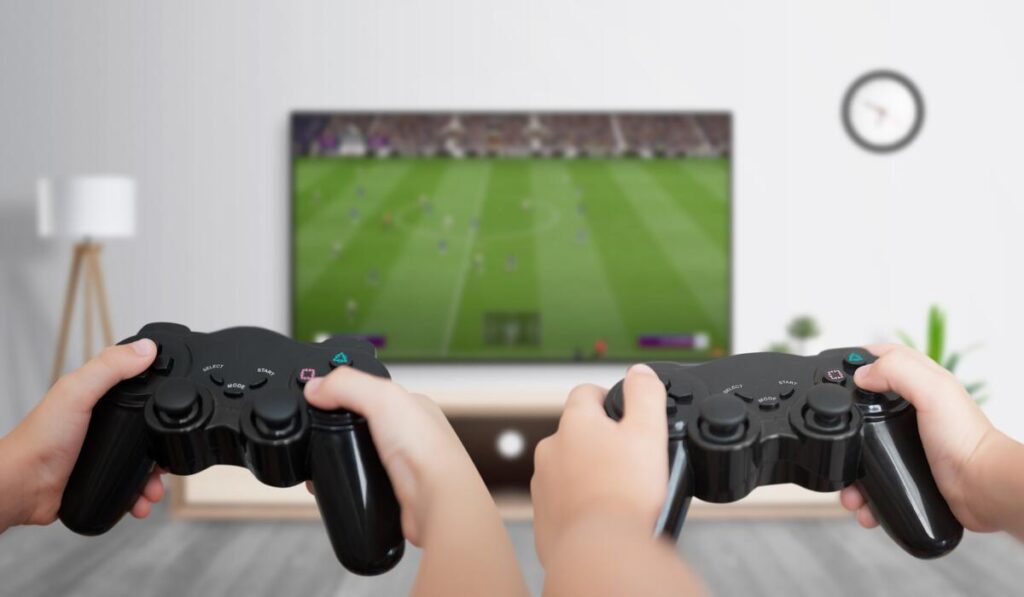TV Sizes and Gaming (12 Things You Should Know)
Disclosure: Tech Parasol is supported by its readers. When you purchase through links on our site, we may earn an affiliate commission. Thank you.
When it comes to TVs and gaming, things like resolution, refresh rate, HDMI 2.1, VRR and so on are the things that are most talked about online.
But one thing that is mentioned to a lesser degree is the actual size of the TV and whether or not it affects the gaming experience.
So that’s what we’re going to focus on in this article.
So here are 12 things you need to know when it comes to choosing the size of a gaming TV.

Does TV size affect gaming?
In short, TV size does not affect gaming.
But some gamers choose to use a large TV when playing split-screen, multiplayer games.
Other gamers say that large TVs have affected their gameplay because it makes it more difficult to look around and there’s more to keep track of.
Sometimes, you have to physically move your head a lot to be able to scan the entire screen.
But most of the time, your eyes will be concentrated on a fairly small area in the middle of the screen.
On the other hand, it can be quicker to absorb the information presented on a smaller TV because it’s all within your field of view and requires minimal eye/head movement.
But it can make it more difficult to see players that are further away.
Some gamers choose to game on monitors rather than TVs, but this has little to do with the size of the display.
Rather, monitors (especially gaming focused ones) have lower input lags and response times than larger, cheaper TVs.
Lower input lags mean that the TV can react quicker to button presses. Lower response times mean that the pixels on the screen can change from one color to another quickly.
With that being said, TVs are catching up to monitors when it comes to input lag.
The very latest high end TVs have extremely low input lags (less than 10ms!) when game mode is activated.
This can often rival most non-gaming focused monitors.
Are big TVs good for gaming?
Big TVs can be great for gaming and they can make gaming more enjoyable and provide a more immersive feel.
Often big TVs are the centerpiece of a living room which can make gaming all the more comfortable.
Also, gaming on a large TV can make gaming more of a social occasion for friends and family, rather than being a solitary activity.
Some people also like to watch others playing a game, particularly if the person they’re watching is a good player. Bigger TVs can make this easier.
Big TVs can also be good for particular genres of games.
For example, if you play games like the Sims, Minecraft or Civilization, you’ll benefit from a bigger screen.
Slower Role Playing Games (RPGs) and racing games can also look great on large TVs.
Are small TVs good for gaming?
Small screen TVs can also be good for gaming.
They are particularly good for First Person Shooters (FPS) like Call of Duty because you don’t have to move your eyes very far to see the entire scene or the mini map in the corner.
Many pro gamers and enthusiasts prefer to game on 24 inch monitors because it keeps the scene within their central vision.
That’s not to say larger screens aren’t suited to these types of games, but you may need to adjust your viewing distance, which may not always be possible in your main living space.
Sitting further back can also reduce your ability to read text on features such as Head Up Displays.
Is it easier to game on a smaller TV?
It’s not necessarily easier to game on a smaller TV as things are often smaller.
So you have to either concentrate more or get closer to the screen to see things.
This can mean that your eyes will get tired much faster leading to a loss of concentration. This can affect how well you play the game.
Do games look worse on bigger TVs?
Although games can look worse on some bigger TVs, the picture quality in a game isn’t related to its size.
Things that affect picture quality include but are not limited to the display technology (OLED vs LED for example), resolution, pixel density, contrast ratio, color accuracy and HDR brightness.
A large high end TV such as the LG C1 is going to look a lot better for gaming than a standard 4K 32 inch TV.
On the other hand, a decent quality 32 inch TV such as the QN32Q60AAFXZA can look better than a cheap 65 inch TV.
Do bigger TVs affect FPS gaming?
The size of a TV and the FPS (Frames Per Second) are not related.
But the resolution of the TV can affect the number of frames per second you get in the game.
Generally speaking, the higher the resolution, the lower the FPS.
This is because the more pixels there are, the more work there is to be done per frame to render the image and the lower the frame rate will be.
Do big TVs have more input lag
There’s no correlation between the size of a TV and the amount of input lag. So big TVs don’t have any more input lag than smaller TVs.
The three main things that contribute to input lag are:
Image acquisition
The longer it takes the TV to receive the images from a source, the longer the input lag will be.
HDMI cables are the solution here, because signals can be transferred from the source to the TV almost instantly.
Video Processing
TVs always perform some processing on the signal before it’s rendered on the screen.
This includes things like increasing the image brightness and adjusting colors, upscaling the content to the display resolution and adding in Variable Refresh Rates (VRR).
But the more processing the TV carries out, the longer the input lag will be. The actual speed of the processor is also a factor in how much input there will be.
Enabling game mode on your TV can help here as it can reduce the amount of video processing that is carried out. But this comes at the expense of picture quality,
But high-end TVs such as the LG C1 have very low input lags when game mode is activated which can rival some non-gaming monitors.
Still, many gamers prefer to use a dedicated gaming monitor which offers even lower input lags (less than 2ms!) and low response times.
Displaying the Image
One the signal has been processed, the images are then sent to the display to be rendered.
Of course the images aren’t rendered instantly and the time it takes depends on the display technology and the panel.
Is a 32 inch TV big enough for gaming?
A 32 inch TV is big enough for gaming if you sit relatively close to it.
With a 32 inch TV you have the advantage of being able to view the entire screen without moving your head or eyes too far.
The downside of getting a 32 inch TV for gaming is that they’re not all available in 4K and may not have the gaming features that you might get on a larger, high-end TV.
Is a 43 inch TV good for gaming?
A 43 inch TV is great for gaming. It’s suitable for a smaller room such as a bedroom, but it’s also big enough for use in a larger living area.
I personally have a 42 inch Sony Bravia and I find it to be a good size for gaming when sitting a few feet away from it.
It’s not too small that I have trouble reading text etc but it’s not so big either that I have to constantly move my head around to see everything!
Is a 75 inch TV good for gaming?
A 75 inch TV can be excellent for gaming. A TV of this size will give you a very immersive experience.
Split screen multiplayer gaming on a 75 inch TV can be a breeze, providing a decent amount of real estate for each player.
A 75 inch TV can also make it easier for friends to gather around it for a gaming session.
Is a smaller TV better for Fortnite?
A smaller TV can be better for playing games such as Fortnite because smaller screens make it easier to see people and require less head and eye movement.
Many players recommend investing in a smaller 24 inch gaming monitor for this reason.
Gaming monitors also have lower input lags than TVs.
Are there any advantages/disadvantages to playing games on a large TV
Here are some advantages to playing games on a large TV:
Advantages
- Easier to play split screen, multiplayer games
- More immersive experience
- Easier for people to gather around a large TV when gaming for social occasions
- Characters and other items in the game will appear bigger so you don’t have to concentrate as much or sit as close to see things
And here are the disadvantages:
Disadvantages:
- Can be harder to see the entire screen without head/eye movement
- Larger, cheaper TVs may not look as good as a smaller TV with a higher pixel density
Sources

Robert Anderson
Robert Anderson, the founder of Tech Parasol, had a keen interest in tech from a very young age. He studied Electronic Engineering at University and then went on to become a Software Developer. He launched Tech Parasol in 2021 to share his knowledge with the aim of making tech easier to understand for everyone.
